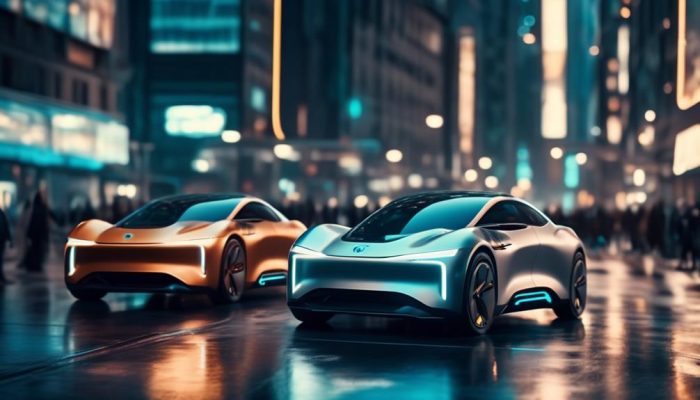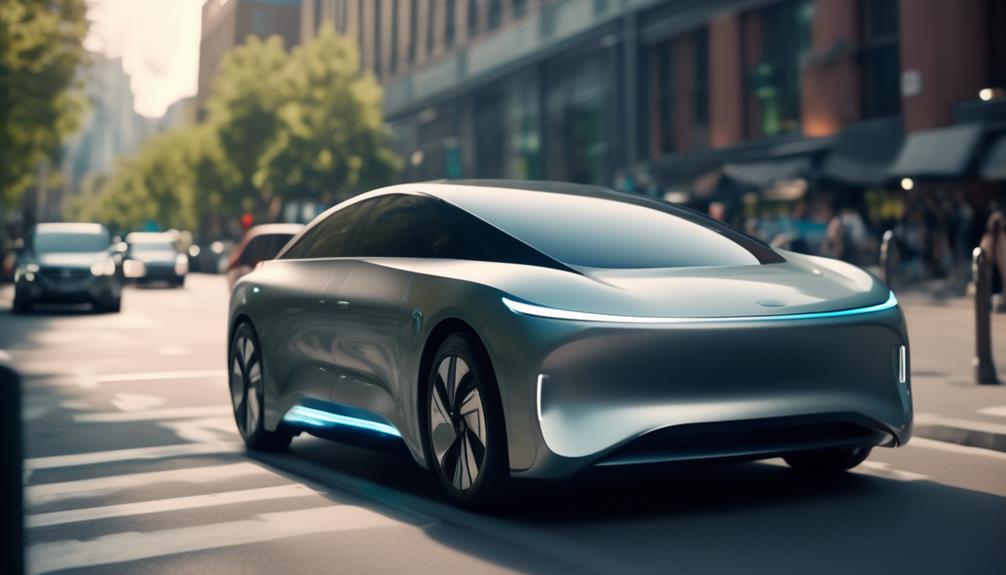
Revolutionary Plug-In Hybrids Set to Dominate 2024
Are you ready to witness a revolution in the automotive world?
Picture a future where plug-in hybrids reign supreme, offering the perfect blend of power and environmental consciousness. In 2024, these groundbreaking vehicles are poised to dominate the market, forever changing the way we think about transportation.
But what makes these plug-in hybrids so revolutionary? What sets them apart from their predecessors?
In this discussion, we will delve into the world of these game-changing vehicles, exploring their features, performance, and potential. Get ready to discover a new era of driving that combines the best of both worlds, and prepare to be amazed.
Key Takeaways
- Hybrid cars come in various forms, including peak performance cars, hydrogen-powered cars, and plug-in hybrid cars.
- Plug-in hybrid cars offer long ranges compared to pure electric cars and can be fully charged at home in less than 10 hours.
- The Polestar 1 is considered the best plug-in hybrid car with an impressive electric range of 52 EPA miles and powerful performance.
- The Range Rover Sport Autobiography is a top-performing and more affordable hybrid electric car with a certified electric range of 51 miles and off-road capabilities.
- The BMW X5 xDrive50e is a more affordable plug-in hybrid car known for its practicality, storage capacity, and impressive handling.
- The Volvo XC60 Recharge is a reliable plug-in hybrid SUV with a starting price in the low $40,000 range, good performance in various conditions, and a total range of over 500 miles.
Understanding Hybrid Car Technology

Understanding hybrid car technology is essential for anyone interested in the future of automotive transportation.
Hybrid cars offer a combination of an internal combustion engine and an electric motor, providing several advantages and disadvantages.
One of the pros of hybrid car technology is improved fuel efficiency, as the electric motor assists the engine during acceleration. This leads to reduced fuel consumption and lower emissions, resulting in a positive environmental impact.
Additionally, hybrid cars have regenerative braking systems that capture and store energy normally lost as heat, further improving efficiency.
However, there are also cons to consider. Hybrid cars tend to be more expensive than traditional vehicles, and their batteries can be costly to replace.
Additionally, the manufacturing process of hybrid cars can have a higher environmental impact due to the extraction of raw materials for battery production.
Polestar 1
The Polestar 1 stands out as the best plug-in hybrid car on the market for several reasons. First, it offers powerful performance with its 600 horsepower, 738 pound-feet of torque, and impressive 0 to 60 time of 4.3 seconds. Its gas engine, equipped with a supercharger and a turbocharger, ensures optimal power output.
Second, the Polestar 1 exudes luxury and exclusivity. Priced at $150,000, it is a car that turns heads on the road. Its stunning looks and rare availability make it a true standout. Considered a rolling art, the Polestar 1 offers an exquisite level of exclusivity.
Lastly, the Polestar 1 combines advanced hybrid technology with high-performance capabilities. Its plug-in hybrid system offers a long electric range of 52 EPA miles, providing the convenience of electric driving. This eliminates range anxiety and allows for long-distance travel without compromising performance.
In terms of performance and exclusivity, the Polestar 1 sets a new standard for plug-in hybrid cars. It surpasses its competitors like the Range Rover Sport Autobiography, offering style, off-road capabilities, and an exceptional driving experience.
Range Rover Sport Autobiography

Now let's turn our attention to the Range Rover Sport Autobiography, a top-performing hybrid electric car from Jaguar Land Rover that offers both style and electric capabilities.
Priced over $120,000, this SUV combines the elegance and ruggedness of a Range Rover with the affordability and electric capabilities of a plug-in hybrid. With a certified electric range of 51 miles and a quick 0 to 60 time of 4.7 seconds, the Range Rover Sport Autobiography is a compelling choice for those seeking luxury and environmental consciousness.
Its off-road capabilities and good looks make it a standout in its class. However, potential buyers may have concerns about Jaguar Land Rover's electric pivot and the higher price tag. Nonetheless, the Range Rover Sport Autobiography remains a desirable option for those looking for a stylish and capable hybrid electric SUV.
BMW X5 Xdrive50e
The BMW X5 Xdrive50e is a practical and affordable plug-in hybrid car that offers impressive performance and utility. Here are the pros and cons of the BMW X5 Xdrive50e:
- Pros:
- Decent horsepower and torque, with 483 horses and a 0 to 60 time of 4.6 seconds.
- Practicality with its storage capacity and potential for good performance in inclement weather.
- BMW's established reputation and extensive dealer network provide a more convenient service experience.
- Cons:
- May have a stiffer ride compared to other plug-in hybrids.
- Charging time may be longer compared to some competitors.
- Limited electric range compared to some other plug-in hybrid cars.
When it comes to performance comparison, the BMW X5 Xdrive50e holds its own against other plug-in hybrids in its class. It offers a competitive acceleration time and decent horsepower. However, it may fall behind in terms of electric range compared to some of its rivals.
Volvo XC60 Recharge

As we shift our focus to the Volvo XC60 Recharge, let's explore another practical and reliable option in the plug-in hybrid car market.
The Volvo XC60 Recharge offers around 20 miles of electric range, which isn't as impressive as some of its competitors. However, newer models have double that range, making it more appealing for those looking for extended electric driving capabilities.
In terms of performance, the XC60 Recharge performs well in various conditions, including snow, thanks to its traction and snow tires. It may not have the most powerful engine, but it delivers a smooth and comfortable ride.
One standout feature of the XC60 Recharge is its towing capacity, which is approximately 3,000 lbs. This makes it a great option for those who need to tow trailers or small boats.
Other Revolutionary Plug-In Hybrids
In the realm of plug-in hybrids, there are other revolutionary options that are pushing the boundaries of electric driving and performance. These groundbreaking advancements are driving market competition and offering consumers a wider range of choices.
Here are three other revolutionary plug-in hybrids to consider:
- Porsche Panamera Turbo S E-Hybrid: This luxury sports car combines a twin-turbo V8 engine with an electric motor, delivering a whopping 690 horsepower and 642 lb-ft of torque. With a 0 to 60 time of just 3.0 seconds, it offers exhilarating acceleration and impressive handling. The Panamera Turbo S E-Hybrid proves that plug-in hybrids can deliver both power and efficiency.
- Audi Q5 TFSI e: This compact SUV boasts a plug-in hybrid powertrain that combines a turbocharged four-cylinder engine with an electric motor, producing a total output of 362 horsepower and 369 lb-ft of torque. It offers an electric range of up to 20 miles and can reach 60 mph in just 5.0 seconds. The Q5 TFSI e provides a balance of performance, versatility, and fuel efficiency.
- Ford Escape Plug-In Hybrid: This compact crossover SUV offers a plug-in hybrid option that provides an electric range of up to 37 miles. With a total system power of 221 horsepower and a quick 0 to 60 time, the Escape Plug-In Hybrid delivers both efficiency and agility. It also offers a spacious interior and advanced safety features, making it a practical and eco-friendly choice.
These other revolutionary plug-in hybrids are proof that the future of electric driving is bright. With their innovative technology and impressive performance, they're setting new standards in the market and giving consumers more options than ever before.
Advantages of Plug-In Hybrids

Plug-In hybrids offer a multitude of advantages over traditional gasoline-powered vehicles, making them an attractive option for environmentally conscious consumers. One of the main advantages is their ability to switch between electric and gasoline power, providing flexibility and extended range. This eliminates the range anxiety often associated with fully electric vehicles.
In addition, plug-in hybrids have lower emissions compared to gasoline-powered vehicles, reducing air pollution and greenhouse gas emissions. They also offer potential cost savings, as they require less fuel and may qualify for government incentives and lower tax rates.
As technology continues to advance, plug-in hybrids are expected to undergo further development, resulting in improved battery efficiency, increased electric range, and faster charging times. With these advantages and future developments, plug-in hybrids are poised to play a significant role in the transition towards a more sustainable transportation system.
The Future of Plug-In Hybrids
The growing demand for sustainable transportation and advancements in hybrid car technology are driving the future of plug-in hybrids towards greater efficiency and improved performance. Here are three future market trends and their potential environmental impact:
- Increased Electric Range: Plug-in hybrids are expected to have longer electric ranges in the future, allowing for more emissions-free driving. This will reduce the overall environmental impact of these vehicles by reducing the reliance on fossil fuels and lowering greenhouse gas emissions.
- Enhanced Battery Technology: The development of more advanced battery technology will lead to improved energy storage and longer-lasting batteries for plug-in hybrids. This will increase the efficiency of these vehicles and further reduce their environmental footprint.
- Integration of Renewable Energy: The future of plug-in hybrids involves integrating renewable energy sources, such as solar power, into the charging process. This will enable owners to charge their vehicles using clean and sustainable energy, further minimizing their environmental impact.
As the demand for sustainable transportation continues to grow, plug-in hybrids are poised to play a significant role in the future automotive market. With advancements in technology and a focus on environmental impact, these vehicles have the potential to provide efficient and eco-friendly transportation options for years to come.
Frequently Asked Questions
What Are the Advantages of Plug-In Hybrid Cars Compared to Traditional Gasoline-Powered Cars?
Plug-in hybrid cars have several advantages compared to traditional gasoline-powered cars. They offer long ranges, reduce emissions, and can be charged at home. They combine the convenience of a gas engine with the efficiency of an electric motor.
How Long Does It Typically Take to Fully Charge a Plug-In Hybrid Car at Home?
It typically takes less than 10 hours to fully charge a plug-in hybrid car at home. This charging time is cost-efficient compared to traditional gasoline-powered cars, making plug-in hybrids a convenient and environmentally friendly option.
What Is the Electric Range of the Polestar 1?
The electric range of the Polestar 1 is an impressive 52 EPA miles. This gives it a significant advantage over other plug-in hybrids, allowing you to enjoy longer electric drives and reduce your reliance on gasoline.
How Does the Range Rover Sport Autobiography Combine the Style of a Range Rover With Its Electric Capabilities?
The Range Rover Sport Autobiography combines the style of a Range Rover with its electric capabilities, offering a certified electric range of 51 miles. This plug-in hybrid SUV also has a starting price range in the low $120,000s.
What Is the Starting Price Range for the Volvo XC60 Recharge?
The starting price range for the Volvo XC60 Recharge is in the low $40,000 range. Plug-in hybrid cars, like the XC60 Recharge, have advantages over traditional gasoline-powered cars, such as lower emissions and the ability to drive on electric power alone.
Conclusion
As you navigate through the world of electric vehicles in 2024, the revolution of plug-in hybrids is undeniable.
These vehicles, like the Polestar 1 and Range Rover Sport Autobiography, symbolize a new era of automotive innovation.
They offer the best of both worlds, merging convenience and eco-friendliness seamlessly.
With their cutting-edge technology, plug-in hybrids are reshaping the automotive landscape, allowing you to drive with exhilaration while reducing your carbon footprint.
Embrace the evolution and join the movement towards a greener future.
